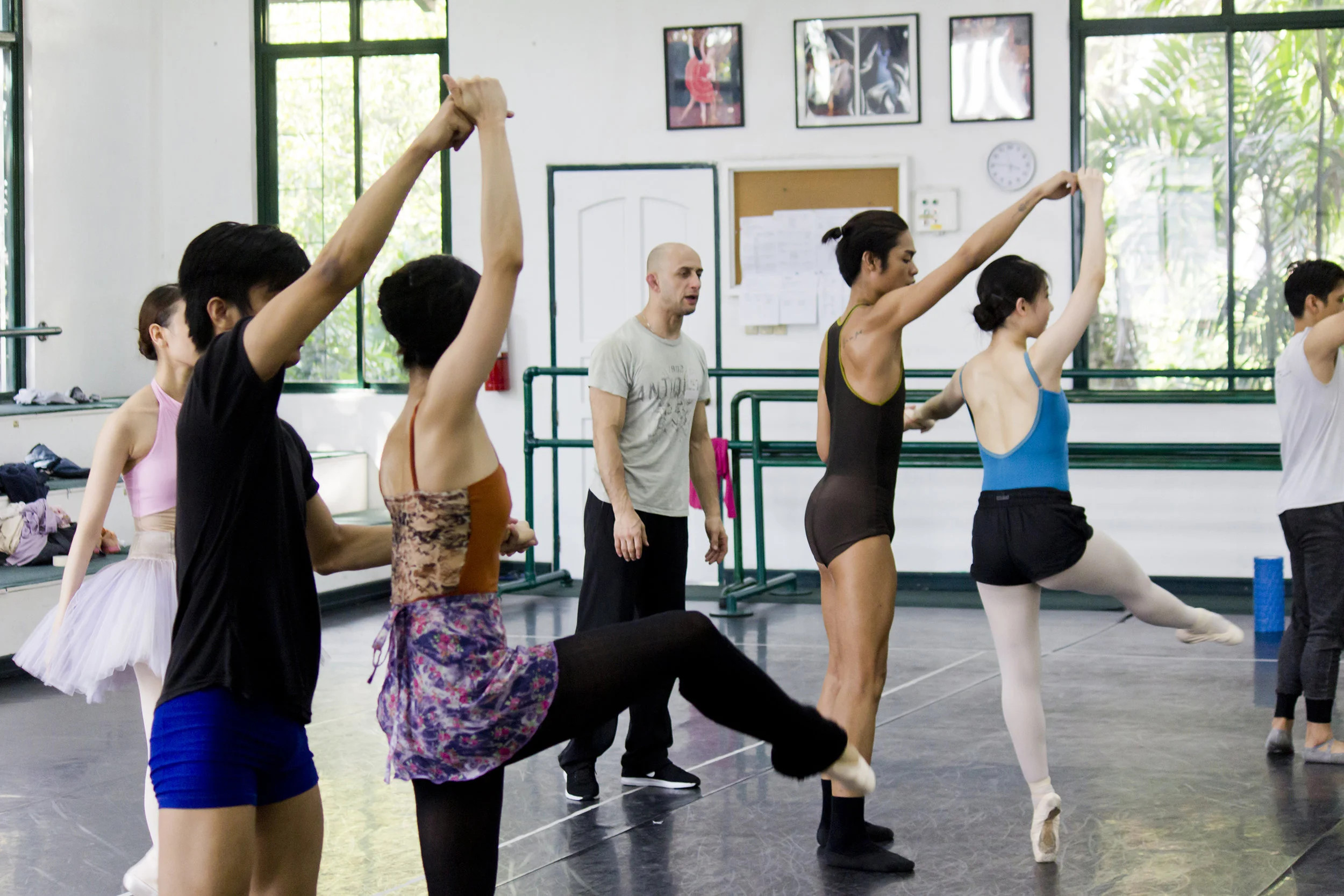Choreography in Focus: Deconstructing Gershwin by Hazel Sabas
Lisa Macuja-Elizalde and Osias Barroso lead a ten-member Ballet Manila cast for Hazel Sabas’ Deconstructing Gershwin which made its Asian debut and Philippine premiere in 1999. Photo from the Ballet Manila Archives collection
When the repertoire for Ballet Manila’s American Stars Gala was being lined up, artistic director Lisa Macuja-Elizalde immediately thought that Hazel Sabas’ Deconstructing Gershwin would be a perfect fit.
“After all, what could be more American than Gershwin?” said the prima ballerina, who is a long-time friend and colleague of the choreographer.
And so, Ballet Manila opened American Stars Gala with ten of its present crop of dancers breathing new life to the critically-acclaimed choreography, set to a string of Ira and George Gershwin tunes as played by Herbie Hancock, Dubose Heyward and Dave Grusin.
The choreography – whose cast members in 2005 included Jonathan Janolo, Sofia Sangco, Jerome Espejo and Marcus Tolentino – is meant to reflect Gershwin music’s essence and spirit. Photo from the Ballet Manila Archives collection
Deconstructing Gershwin made its Asian debut and Philippine premiere in July 1999 when Ballet Manila featured it in its season production, An Evening of Filipino Ballet, at GSIS Theater. The show also included another piece by Sabas, Minamahal, along with Tony Fabella’s Sugar Step Elizalde, Ric Culalic’s Ouch and Arnis and Edna Vida’s Flux.
The work had premiered months before as a competition piece. In an e-mail interview, Sabas – then US-based – recalls that she had first heard of the 1st International Competition of Classical Choreography when it was advertised in Dance Magazine.
She sent a video of her work to the competition panel. Out of 400 entries from different parts of the world, only seven finalists were selected. Sabas was one of them, one of two finalists chosen from the US, with others coming from Germany, Austria, Norway and France. The pieces were to be performed at the Auditorium des Halles in Paris in March 1999.
“I made an arrangement with Ballet Memphis director, Dorothy Gunther-Pugh, to help me with the project. Thus, the new work Deconstructing Gershwin was created. She was thrilled for my finalist entry and she was also honored that six of her company dancers would be participating, which provided international exposure for Ballet Memphis,” relates Sabas, who had been ballet mistress of the Tennessee company for three years.
Deconstructing Gershwin makes its comeback in 2018’s American Stars Gala. The number’s opening sequence features Heewon Cho, John Ralp Balagot, Jamil Montibon, Sean Pelegrin and Nanami Hasegawa. Photo by Giselle P. Kasilag.
Due to time limitations, she recalls that she only had less than a week to finish the choreography which had a length of 17 minutes.
Her inspiration was mainly the essence of Gershwin’s music and the various musical interpretations by different artists. “I also took inspiration with what the dancers could offer to me in terms of creativity, artistry and technique. I wanted to match what Gershwin’s music was about -- its different colors, dynamics and vibrancy,” she notes.
She put together a suite of various interpretations of Gershwin’s compositions. Some were African-inspired, vocals, jazz and classical piano. Movements ranged from glimpses of jazz, lyrical, ballet, contemporary and athletics.
At the time, because she was representing the United States, Sabas thought it would be most appropriate to use something truly American -- the composer, the music genre, the contemporary style.
She counts the Russian masters Prokofiev and Rachmaninoff as her favorite composers, but has had an appreciation for Gershwin’s music, especially from his genre. “He captured the American spirit and the essence of the times. The music of George Gershwin captured America, its urban romance and its true essence. His music was as dynamic as the times and was apt for the intention that I had to be a representative of America in its authentic spirit.”
Jeffrey Espejo, Sandra Lynn Huang and Eduardo Espejo recreate steps from Deconstructing Gershwin for a publicity shoot for An Evening of Filipino Ballet in 1999. Photo from the Ballet Manila Archives collection
She had a simple advice for the Ballet Memphis dancers who formed the original cast: “I told them to think outside the box, let go and have fun, like Gershwin music’s essence and spirit.”
Sabas recalls she had so much fun choreographing the work with the very talented Ballet Memphis dancers. She was also thrilled to later receive the best review in the French newspaper Le Figaro, by famous critic René Sirvin, which partly read: “From the seven competitors, only one showed real invention and originality: the American choreographer originating from the Philippines, Hazel Sabas-Gower, whose six excellent dancers of Ballet Memphis performed the ingenious choreography Deconstructing Gershwin on percussions and jazz rhythms used with humor.”
Sirvin also cited her for her invention and dynamism. “It was truly an honor,” says Sabas who today is a faculty member at the School of the Arts Singapore.
Rudy De Dios, Jerome Espejo and Gabriella Galvez dance the Gershwin-inspired choreography in 2005. Photo from the Ballet Manila Archives collection
When Deconstructing Gershwin made its Philippine premiere, Ballet Manila decided to cast ten dancers which meant a few adjustments and revisions. But essentially, the movements were kept as in the original.
Since then, the choreography has resurfaced in various Ballet Manila productions.
Sabas was happy to receive news that Macuja-Elizalde would be including Deconstructing Gershwin in American Stars Gala, bringing it back not just for a new generation of dancers but also for a new audience. She thanked Lisa in a Facebook post “for keeping my choreography alive through the exquisite dancing of Ballet Manila dancers”..
In turn, Macuja-Elizalde replied: “Thank you for a beautiful ballet that will never go out of style!”
Hazel Sabas is happy that her work continues to be seen onstage, most recently in Ballet Manila’s American Stars Gala. Photo by Giselle P. Kasilag.






